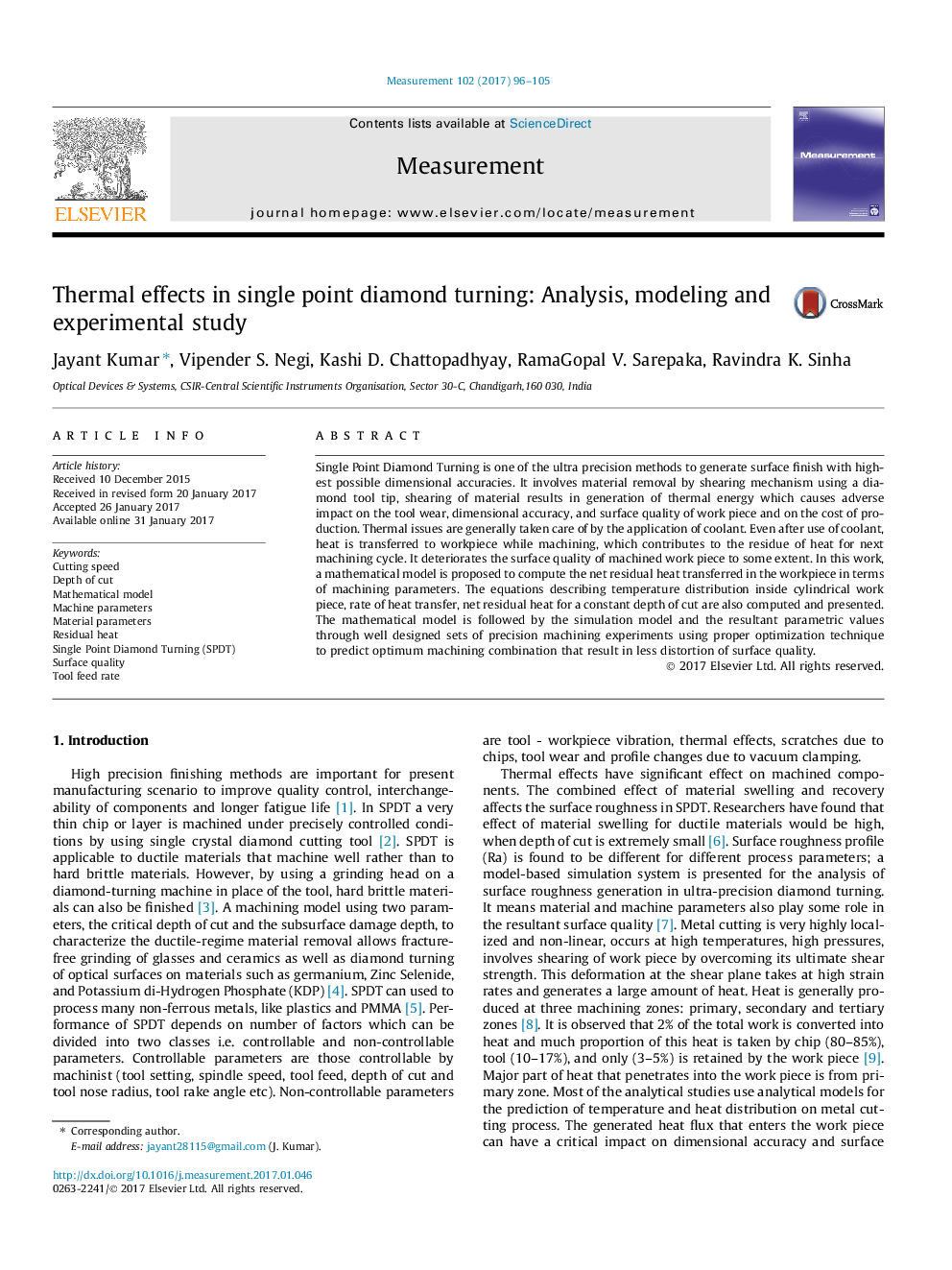| کد مقاله | کد نشریه | سال انتشار | مقاله انگلیسی | نسخه تمام متن |
|---|---|---|---|---|
| 5006791 | 1461485 | 2017 | 10 صفحه PDF | دانلود رایگان |
عنوان انگلیسی مقاله ISI
Thermal effects in single point diamond turning: Analysis, modeling and experimental study
ترجمه فارسی عنوان
اثرات حرارتی در چرخش الماس تک نقطه ای: تجزیه و تحلیل، مدل سازی و مطالعه تجربی
دانلود مقاله + سفارش ترجمه
دانلود مقاله ISI انگلیسی
رایگان برای ایرانیان
کلمات کلیدی
ترجمه چکیده
یکی از روشهای فوق العاده دقیق برای به دست آوردن سطح سطح با بالاترین میزان دقیق احتمالی بعدی الماس یک نقطه است. این شامل حذف مواد توسط مکانیزم برش با استفاده از نوک ابزار الماس، برش مواد از نتایج حاصل از تولید انرژی حرارتی است که تاثیر منفی بر سایش ابزار، دقت ابعاد و کیفیت سطح قطعه کار و هزینه تولید دارد. مسائل حرارتی به طور کلی توسط استفاده از خنک کننده مراقبت می شود. حتی پس از استفاده از خنک کننده، گرما در هنگام ماشینکاری به قطعه کار منتقل می شود، که باعث می شود باقی مانده گرما برای چرخه ماشینکاری بعدی. کیفیت سطح قطعه کاری ماشینکاری تا حدودی کاهش می یابد. در این کار، یک مدل ریاضی برای محاسبه گرمای خالص خالص منتقل شده در قطعه کار از نظر پارامترهای ماشینکاری پیشنهاد شده است. معادلات توصیف توزیع دما در داخل قطعه کار استوانه ای، سرعت انتقال حرارت، گرما باقی مانده خالص برای عمق ثابت برش نیز محاسبه و ارائه شده است. مدل ریاضی به وسیله مدل شبیه سازی و مقادیر پارامتری حاصل از طریق مجموعه ای از مجموعه های طراحی شده از آزمایشات ماشینکاری دقیق همراه با استفاده از روش بهینه سازی مناسب برای پیش بینی ترکیب ترکیبی ماشینکاری بهینه ای که منجر به کاهش اعوجاج کیفیت سطح می شود، دنبال می شود.
موضوعات مرتبط
مهندسی و علوم پایه
سایر رشته های مهندسی
کنترل و سیستم های مهندسی
چکیده انگلیسی
Single Point Diamond Turning is one of the ultra precision methods to generate surface finish with highest possible dimensional accuracies. It involves material removal by shearing mechanism using a diamond tool tip, shearing of material results in generation of thermal energy which causes adverse impact on the tool wear, dimensional accuracy, and surface quality of work piece and on the cost of production. Thermal issues are generally taken care of by the application of coolant. Even after use of coolant, heat is transferred to workpiece while machining, which contributes to the residue of heat for next machining cycle. It deteriorates the surface quality of machined work piece to some extent. In this work, a mathematical model is proposed to compute the net residual heat transferred in the workpiece in terms of machining parameters. The equations describing temperature distribution inside cylindrical work piece, rate of heat transfer, net residual heat for a constant depth of cut are also computed and presented. The mathematical model is followed by the simulation model and the resultant parametric values through well designed sets of precision machining experiments using proper optimization technique to predict optimum machining combination that result in less distortion of surface quality.
ناشر
Database: Elsevier - ScienceDirect (ساینس دایرکت)
Journal: Measurement - Volume 102, May 2017, Pages 96-105
Journal: Measurement - Volume 102, May 2017, Pages 96-105
نویسندگان
Jayant Kumar, Vipender S. Negi, Kashi D. Chattopadhyay, RamaGopal V. Sarepaka, Ravindra K. Sinha,
